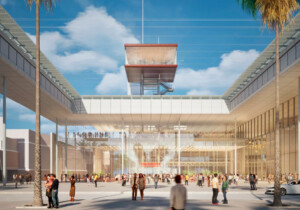This article appears in The Architect’s Newspaper’s April 2017 issue, which takes a deep dive into Florida to coincide with the upcoming AIA Conference on Architecture in Orlando (April 27 to 29). We’re publishing the issue online as the Conference approaches—click here to see the latest articles to be uploaded.
Increasing economic and environmental pressures have the potential to challenge the resiliency of South Florida’s low-lying urban areas in the near future. As Florida’s population continues to grow in the midst of the increasingly obvious impacts of gentrification, global climate change, and sea level rise, economic and environmental displacement are likely to make the northern city of Jacksonville a beacon of hope for a climate-ravaged state.
Why? Because Jacksonville is huge and has room to grow. The city, named after President Andrew Jackson, also first governor of Florida, is the state’s largest by population and the 12th largest in the U.S., population-wise, with 868,031 residents. Jacksonville is also the largest city in the U.S. by land area—874.3 square miles—making it almost twice the size of Los Angeles and about three times that of New York City. The city’s corresponding 1,142 people per square mile density—L.A. and New York are many times denser—means there is plenty of room to grow.
Ruth L. Steiner, professor and director at the Center for Health and the Built Environment in the department of Urban and Regional Planning at the University of Florida, Gainesville, said: “I think the area is amenable to accepting large amounts of new growth,” adding that though the region could likely support an influx of new residents, its schools, transportation, and land-use policies would need a healthy dose of re-thinking to be ready.
A question regarding the massive growth in southern and central Florida, however, centers around the long-term sustainability of these new population centers as the impacts of climate change and sea level rise threaten the state’s coastal communities. With sea levels predicted to rise between four inches and up to ten feet across the region, low-lying areas of the Miami region will see massive losses in real estate and untenable retrofitting costs. The simultaneous and ongoing population growth across that region will likely ultimately push residents to flee to higher, cheaper ground.
That’s where Jacksonville comes in. Though some parts of the city lie on the coast, much of the city’s land area currently sits roughly 16 feet above
sea level. As of 2010, Jacksonville had 366,273 households with an 11.8 percent vacancy rate, meaning that roughly 43,220 units are currently unoccupied. The relatively high vacancy rate means lower rents and, maybe more importantly, lower economic barriers to homeownership for first-time buyers—a growing problem for Miami’s millennial residents. Jacksonville is also home to the nation’s largest urban parks system, with 80,000 acres of parkland distributed across 337 sites, which according to Steiner, “bodes well” for any future urban development. She explained, “Investment in public infrastructure like parks has a high level of pay-back in terms of raising quality-of-life.”
Steiner added that the city faces challenges in terms of its urban layout; “another dilemma is the city’s sprawled out urban form,” she said, adding that because most of the development in the city has happened since World War II, the city is organized along “a series of major arterials and mega-blocks,” a 3,400-mile long network of roads that deters pedestrian-oriented design. Jacksonville also has a bus-only transit system that, aside from a downtown monorail line, leaves much to be desired in terms of mass transit.
The city, a short drive from the University of Florida’s Gainesville campus, is, however, poised for knowledge worker growth. Not only that, but the vast majority of Florida’s recent population growth is not from an increase in births or even migration from other American states, but from a net influx of individuals moving to the state from foreign countries, with Cuban, Venezuelan, and Haitian immigrants showing up in the highest numbers. The impact of climate change on those countries is currently unknown, but it is safe to assume that those communities would continue to grow should conditions back home deteriorate.
In a not-too-far-off future, could Jacksonville provide a relief valve for the growing state? It’s likely, and if city officials can prepare accordingly, Jacksonville’s new residents might learn to love the city. “Sometimes,” Steiner added, “I think Jacksonville is a diamond in the rough.”










